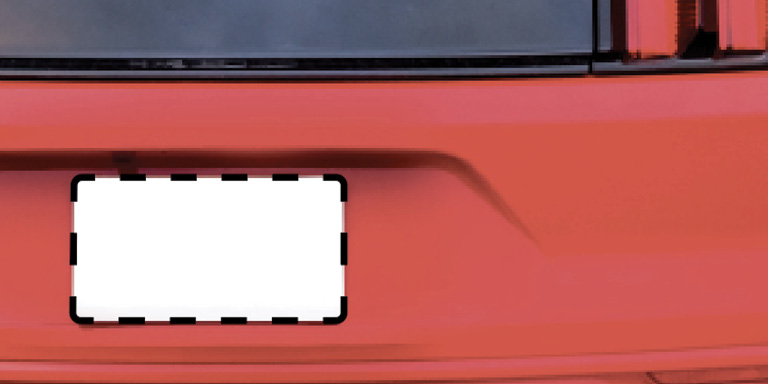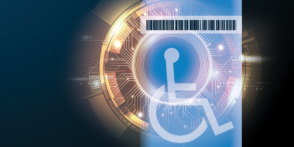Stepping Up To the Plate
From digital plates to vinyl wraps, alternative license plates present potential advantages and challenges
Metal license plates have been the standard for decades. But that may change as more vehicles with alternative plates show up on the roads.
With advances in technology, these newer plates have capabilities that traditional plates don’t have, such as ease of installation and the ability to automatically update vehicle registration information. Several states have approved the use of alternative license plates, and several more are considering it. As DMV administrators and law enforcement weigh the potential costs and benefits, they must keep in mind that no matter what materials they’re made of or how they appear, the plate’s most important purpose—identifying vehicles on the road—remains the same.
The Cool Factor
Alternative license plates aren’t a new concept. They were first used during World War II when a metal shortage forced states to use different materials, such as embossed fiberboard, cardboard and soybean-based plastic. Today’s alternative plates, by comparison, are products of technology.
Vinyl-wrapped plates are made of a malleable adhesive that can only be attached to the front of a vehicle and don’t require any drilling or installation of frames or brackets. Digital plates are either battery-operated or wired to connect to the vehicle’s
electrical system and can only be installed on the rear of a vehicle. The wired version has a built-in GPS that can track a vehicle’s location, especially helpful in cases of stolen cars or kidnappings, though critics have voiced privacy concerns.
The appeal of alternative plates for drivers is their aesthetic, says Marcy Coleman, AAMVA’s Vehicle Programs Manager. “It’s the cool factor. It’s new and different. They have been advertised to have certain capabilities, like showing silver and amber alerts.”
Plates are linked to a central computer system, which could be a DMV system or a system operated by the digital plate vendor. “Digital plate vendors advertise having the ability to perform registration renewals and push the updated registration information to the plate itself,” Coleman explains. She is quick to point out that the plates’ advertised capabilities are not currently in use because digital plates are not yet integrated into DMV systems.
“If jurisdictions decide to authorize digital plate use and allow remote registration renewal through a vendor, the DMVs will have to decide if they want to connect their system directly to the plate or run the data through the digital plate vendor,” she says.
The most important consideration for DMV administrators, says Coleman, is to make the newer plates readable so law enforcement can read them at night and by technology used by law enforcement and tolling authorities.
California’s Pilot Program
California is one of three states that has approved the public use of digital license plates (the other two being Arizona and Michigan). Through a pilot program, the California Department of Motor Vehicles began testing digital license plates with a small sampling of drivers in 2018 and vinyl-wrapped plates in 2019.
California contracted with Reviver Auto to provide its RPlate to drivers in the sampling. The Reviver website touts numerous capabilities of the RPlate, including the instantaneous updating of vehicle registration information and the ability to view and pay parking tickets and road tolls. There’s also the capability to send alerts if the vehicle is stolen and show silver or amber alerts for missing persons.
“We wanted to explore the types of products that were available, especially as the technology has advanced. How could the new technology make administrators’ jobs easier and provide better services to constituents?” recalls Bernard Soriano, Deputy Director of the California Department of Motor Vehicles. The state approved the use of alternative plates for all California residents last fall and is finalizing regulations that would make alternative plates a permanent option for California drivers.
The readability of these newer plates is especially critical for law enforcement who routinely read plates to identify vehicle owners or the vehicle type before making a stop.
“Some officers will run the plates before making a stop to check if there are any issues, such as if it’s a stolen vehicle,” explains Mark Headrick, Assistant Chief, Enforcement and Planning Division of the California Highway Patrol. “Most patrol cars aren’t equipped with a license plate reader, so it’s critical that officers be able to clearly read the plates in all types of weather and lighting conditions from a safe distance.”
License plate readers (LPR) are used in numerous scenarios, he adds. They can help officers investigate time-sensitive incidents, such as missing person reports. They’re also used to track vehicles involved in a crime, whether to commit the crime or to flee the crime scene.
“If the license plate isn’t readable by the LPR system, law enforcement could miss the opportunity to track a vehicle that’s involved in a kidnapping or a missing person case. We also don’t want the LPR to record false or incorrect information because it couldn’t see the license plate clearly,” Headrick says.
Testing for Readability
Some images and color choices can make it difficult for the LPR to read a plate accurately, adds Josh Clements, Sergeant with the California Highway Patrol, Commercial Vehicles, who tests alternative plates for his state.
“Some specialized plates can have special images or messages, and sometimes the LPR can read an image as a character,” Clements explains. “We make sure the cameras can read the plates at different distances and in different light settings. If a plate can’t be read, we ask the license plate provider to modify the colors or redesign the plate for better readability.”
AAMVA works with Element Materials Technology, a third-party lab that tests license plates for jurisdictions to make sure they meet AAMVA’s readability requirements as set forth in the standards document. While the lab does not test alternative license plates yet, the testing process would essentially be the same as for traditional plates, says Drew Snook, Non-Metallic Materials Engineer with Element.
When state plates are submitted for testing, Element checks the sizing of numbers and characters, the spacing between characters, and clarity of colors and graphics so they don’t interfere with the plate number’s legibility. In addition to testing with the human eye, Snook says the lab uses multiple types of license plate readers to view plates during both daylight and no light. The lab also checks for retro reactivity to see if the plate reflects light back toward the reader when headlights shine on it.
Since AAMVA’s testing program began, Snook says the lab has noted several common tendencies about plate designs that can interfere with readability. For example, characters can look the same, such as zeros that look like the letter O, or the number 3 that looks like the letter B.
Graphics can also make it difficult to view a plate properly. Snook recalls testing a plate with an American flag that was printed behind the plate number. “By the naked eye, the design looked fine, but the line between the blue and red of the flag was read by the LPR as the number seven, which was not part of the plate number,” Snook recalls.
Following the New Standard
Whether digital or vinyl-wrapped, alternative plates ideally should meet AAMVA’s readability standards for character and spacing as set forth in AAMVA’s License Plate Standard. Brian Ursino, AAMVA’s Director of Law Enforcement and project manager of AAMVA’s License Plate Standard Working Group, says the License Plate Standards most recent revision (Edition 3) includes a section for Standards for Alternative License Plates and describes the advantages and challenges they present.
“In 2020, when the last document was published, we were still learning about alternative license plates,” recalls Ursino. “Members are encouraged to follow the new Standard to make their plates as readable as possible to both the human eye and license plate reader technology.”
While alternative license plates may look more appealing and promise some potential technology advantages, they still must achieve its main purpose—to help law enforcement identify vehicles in the service of road safety.
Learn more about the License Plate Standard in AAMVAcast Episode 178.




